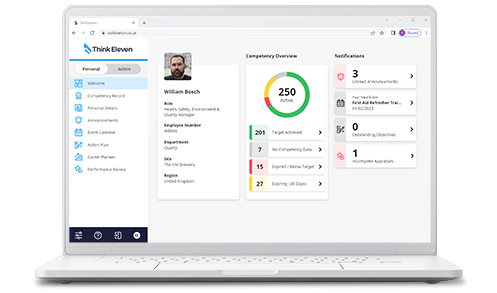External audits are a common and necessary practice across all sectors, ensuring that organisations comply with industry standards and regulatory requirements. Although these audits can be challenging and stressful, they play a vital role in maintaining high standards of safety and quality. This guide provides essential advice and guidance on effectively demonstrating workforce competency during an audit.
The process of external auditing is commonplace across all sectors, serving to ensure that organisations comply with industry standards and regulatory requirements. Whilst these audits can seem difficult and stressful, they play an important role in ensuring that high standards of safety and quality are met.
Audits can cover a wide range of topics affecting various industries, such as health and safety, environmental, and financial regulations, through to industry-specific standards – ISO 9001 for manufacturing organisations for example. A challenging part of this auditing process is being able to effectively and comprehensively demonstrate competence and compliance of the people within your workforce. This guide aims to provide advice and guidance that will help you to prepare and excel in your next audit.
Understanding Competency Management
As a starting point it’s useful to understand why demonstrating workforce competency is critical:
- Regulatory Compliance: Many industries have stringent regulations requiring proof of employee qualifications and competencies.
- Risk Management: Ensuring that your workforce is competent reduces the risk of errors, accidents, and non-compliance issues.
- Continuous Improvement: Demonstrating competency is not just about meeting standards; it’s about striving for excellence and continuous improvement.
A Step-by-Step Guide to Demonstrating competency
1. Centralised Data Management
Keeping all employee data trackable, up-to-date and accessible is made vastly easier with the use of a centralised competency management system. A system, such as SkillStation, will allow you to track and demonstrate information such as:
- Employee Profiles: Comprehensive profiles with personal details, job roles, and contact information.
- Employee Skills Record: A comprehensive list of the role specific and generalist skills an employee possesses.
- Training Records: A log of completed training sessions, dates, and outcomes.
- Qualifications and Certifications: Digital copies of certificates, licenses, and qualifications.
- Performance Reviews: Records of periodic performance evaluations and competency assessments.
2. Structured Competency framework
A Competency Management system will help you to develop and maintain a structured competency framework that outlines the skills, knowledge, and behaviours required for each role within your organisation. This framework should be:
- Role-Specific: Tailored to the specific requirements of each job role.
- Measurable: Include clear, measurable criteria for each competency.
- Dynamic: Regularly updated to reflect changes in industry standards, regulations, and organisational needs.
3. Regular Assessments and updates
A competency management system will assist in conducting regular skills and competency assessments to ensure and verify capability of the workforce. This will include processes such as:
- Periodic Evaluations: Schedule regular performance evaluations and competency assessments.
- Management of Ongoing Training: Provide ongoing training and development opportunities to address skill gaps and emerging needs.
- Continuous Monitoring: Use your online system to continuously monitor progress and update records in real-time.
4. Clear Communication and Transparency
Clear communication and transparency are crucial for effective competency management, and an online competency management system significantly enhances these aspects. With such a system in place, organisations can streamline the communication of updated policies, procedures, and compliance notifications. This process becomes straightforward as the system allows for automated notifications and acknowledgments, ensuring that all employees are promptly informed of any changes or new requirements.
One of the key advantages of using a competency management system is the ability to track compliance with these communications. The system records who has read and acknowledged the updates, providing a clear audit trail. This feature is particularly beneficial during external audits, as it demonstrates that the organisation not only disseminates important information but also ensures that employees are aware and compliant.
Furthermore, the system can generate reports that highlight compliance status across different departments or roles, making it easy to identify any gaps and take corrective actions promptly. This level of transparency fosters a culture of accountability and continuous improvement, as employees are aware that their compliance is being monitored and recorded.
5. Audit-Ready Documentation
A competency management system can help to ensure that training and skills related documentation required for review by the auditor are easily available. The key components of what a competency management system can provide are:
- Audit Trails: A detailed audit trails that document all updates and changes to employee records.
- Compliance Reports: Generate compliance reports that summarise your organisation’s competency status and highlight areas of strength and any skills gaps that need to be addressed.
- Evidence of Competency: Be ready to present evidence such as training certificates, assessment results, and performance reviews.
In Conclusion
In conclusion, effectively demonstrating workforce competency is essential for audit success and overall organisational excellence. By leveraging a centralised competency management system, you can streamline data management, develop a structured competency framework, conduct regular assessments, ensure clear communication and transparency, and maintain audit-ready documentation.
These practices not only facilitate compliance with industry standards and regulatory requirements but also foster a culture of continuous improvement and accountability within your organisation. Preparing thoroughly and utilising the right tools will position your organisation to excel in audits, showcasing your commitment to high standards of safety, quality, and competence. Invest in a robust competency management system today to ensure your workforce is always audit-ready and poised for success.


